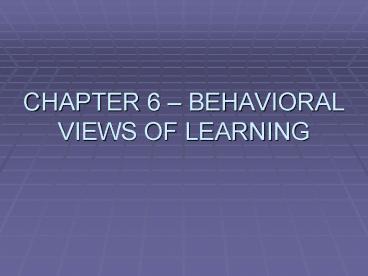CHAPTER 6 BEHAVIORAL VIEWS OF LEARNING - PowerPoint PPT Presentation
1 / 17
Title:
CHAPTER 6 BEHAVIORAL VIEWS OF LEARNING
Description:
CLASSICAL CONDITIONING. Bad/Good experience with a teacher generalizes to all teachers. ... anything that strengthens a behavior Good grades, food, acting out. ... – PowerPoint PPT presentation
Number of Views:524
Avg rating:3.0/5.0
Title: CHAPTER 6 BEHAVIORAL VIEWS OF LEARNING
1
CHAPTER 6 BEHAVIORAL VIEWS OF LEARNING
2
LEARNING
- A process through which experience causes a
permanent change in knowledge or behavior - The outcome of learning from a behaviorist
perspective is a change in behavior and
emphasizes the effects of external events on the
individual.
3
LEARNING THEORIES
- Continguity association of two events because
of repeated pairings. - Classical conditioning Pavlov and his dogs. How
we learn Involuntarily emotional or physiological
responses such as fear, increased heart rate,
salivation , sweating - These responses are automatic to stimuli.
4
PAVLOVS EXPERIMENTS
- Sounding a tuning fork and recording a dogs
response No salivation Neutral stimulus. - Pavlov then fed the dog dog salivated.
- Food unconditioned stimulus because no prior
training or conditioning was needed to establish
the relationship/connection between food and
salivation. - Salivation unconditioned response no
conditioning required
5
Pavlov
- Then sounded a tuning fork, put the food down and
the dog salivated. Repeated the experiment a few
times. - Sound from the tuning fork became conditioned
stimulus when no food presented. - The response of salivating after the tone with no
food conditioned response. - Similar stimuli different sounds, elicited
salivation response generalization. - Extinction conditioned stimulus is presented
repeatedly without the unconditioned stimulus
(food)
6
CLASSICAL CONDITIONING
- Bad/Good experience with a teacher generalizes
to all teachers. - Important for the students to associate learning
a skill with fun or at least a pleasant non
aversive experience whenever possible.
7
OPERANT CONDITIONING
- Thorndike and Skinner.
- OPERAN TS Voluntary and generally goal directed
behaviors emitted by a person or an animal. - OPERANT CONDITIONING Learning in which
voluntary behavior is strengthened or weakened by
consequences or antecedents (events that precede
an action)
8
OPERANT CONDITIONING
- Behavior ---- Reinforcer --- Strengthened or
repeated behavior - Reinforcer anything that strengthens a behavior
Good grades, food, acting out. - Positive reinforcement presenting a desired
stimulus after a response. Falling out of your
chair producing cheers from the class..
9
OPERANT
- Negative reinforcement strengthening a behavior
by removing an aversive stimuli. - Getting sick before an exam the behavior allows
the student to avoid negative situations tests.
It is negative because the stimulus the test
disappears. It is reinforcement because the
behavior that caused the exam to disappear
getting sick increases or repeats. May also be
classical conditioning
10
PUNISHMENT
- Anything that suppresses or weakens a behavior
- Presentation punishment Presentation of an
aversive stimuli following the undesired
behavior. - Teacher assigns extra homework when you have
been bad.
11
PUNISHMENT
- Removal Punishment Teacher takes away a
privilege after the student has behaved
inappropriately. Fines, grounded, getting fired.
12
REINFORCEMENT
- REINFORCEMENT SCHEDULES
- Continuous reinforcement reinforcer is
presented after every correct response.
Effective when learning a new behavior. Once
learned intermittent schedule of reinforcement
most effective. - Interval schedules time is the important
variable - Ratio Number of responses.
13
ANTECEDENTS
- Principal standing in the hall ways during the
start of classes students learn to
discriminate. - CUEING providing a stimulus that sets up a
desired behavior. - - Visual - Standing quietly at the front of the
class and not starting the lesson until everyone
is quiet. - Verbal asking that the students take their
seats - Prompt another cue
14
APPLIED BEHAVIOR ANALYSIS
- Reinforce positive behavior and ignore negative
behavior -General rule - Make a point of commenting on those students who
are accomplishing the task. - IMPORTANT - Must be timely, believable and be
specific. Thank you for completing the assignment
on time and handing it in. - SHAPING Reinforcing successive approximations
small steps. Reinforce progress as well as the
final product - POSITIVE PRACTICE Practice correct responses
immediately after the errors have been made.
15
BEHAVIORAL APPROACHES TO TEACHING AND MANAGEMENT
- MASTERY LEARNING Breaking a course down into
smaller units and then teaching and testing on
those materials. Must get 80 90 before they
can move on. Retesting is given when that is not
accomplished. - Contingency Contract program Teacher draws up a
contract with each student. Gifted and
Developmentally delayed.
16
SELF MANAGEMENT
- Teacher and student negotiate/set out goals and
expectations. - Very good students works well
- Monitoring and self evaluation students keep
track of the work that they have done. Books
read, assignments completed.
17
CRITICISMS OF BEHAVIORAL APPROACH
- Generation who are used to being rewarded for
doing what they are supposed to do - Reinforcing some students may alienate others
- Reinforcing behaviors which the student already
wants to do may actually work against the student
working on their own. - PUNISHMENT AS LAST RESORT - Behavior Disordered
may respond to punishment in an aggressive
manner, generate hostility. - Punishment generally DOES NOT work in terms of
improving learning.. Reinforcement/rewards far
more effective.

